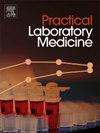Tumor-informed circulating tumor DNA detection for personalized monitoring of treatment response in epithelial ovarian cancer
IF 1.3
Q3 MEDICAL LABORATORY TECHNOLOGY
引用次数: 0
Abstract
Background
Circulating tumor DNA (ctDNA) has emerged as a valuable biomarker in liquid biopsies for monitoring treatment responses in cancer patients. However, detecting ctDNA in epithelial ovarian cancer (EOC) is challenging due to its high heterogeneity and the absence of hotspot driver mutations. Therefore, a personalized approach to ctDNA analysis is essential, tailored to the specific tumor mutations of each EOC patient. In this study, we aimed to evaluate a droplet digital PCR (ddPCR) method targeting various genetic alterations in ctDNA identified through a targeted next-generation sequencing (NGS) panel in EOC tumors.
Methods
EOC tumor tissues were sequenced using a targeted NGS panel to identify oncogenic mutations. ddPCR assays were subsequently designed and optimized to detect these tumor-specific mutations in ctDNA. ctDNA levels were monitored and compared with CA-125 for EOC.
Results
Fourteen pathogenic mutations, including TP53, PIK3CA, PTEN, KRAS, and RB1, were identified in 13 patients with EOC and selected as targets for ctDNA detection. The performance of ddPCR assays was validated for 10 mutations, and mutated ctDNA was successfully detected for 8 mutations in 7 patients. In most cases, ctDNA levels showed trends consistent with CA-125 levels, reflecting the treatment response. However, in one case, PTEN (E91∗) mutated ctDNA was detected during recurrence, while CA-125 levels remained within the normal range.
Conclusion
This study demonstrates the clinical utility of ddPCR for monitoring treatment responses in EOC by targeting patient-specific mutations. Integrating ddPCR with NGS-based mutation identification offers an effective approach for assessing therapeutic outcomes in EOC patients.
肿瘤信息循环肿瘤DNA检测用于上皮性卵巢癌治疗反应的个性化监测
循环肿瘤DNA (ctDNA)已成为监测癌症患者治疗反应的液体活检中有价值的生物标志物。然而,由于上皮性卵巢癌(EOC)的高异质性和缺乏热点驱动突变,检测ctDNA具有挑战性。因此,针对每个EOC患者的特定肿瘤突变,个性化的ctDNA分析方法至关重要。在这项研究中,我们旨在评估一种液滴数字PCR (ddPCR)方法,该方法针对通过靶向下一代测序(NGS)小组鉴定的EOC肿瘤中ctDNA的各种遗传改变。方法采用靶向NGS技术对seoc肿瘤组织进行测序,鉴定致癌突变。随后设计并优化了ddPCR检测方法,以检测ctDNA中这些肿瘤特异性突变。监测ctDNA水平,并与CA-125进行比较。结果13例EOC患者共检出TP53、PIK3CA、PTEN、KRAS、RB1等14个致病突变,并选择这些突变作为ctDNA检测的靶点。验证了ddPCR检测10个突变的性能,并成功检测了7例患者中8个突变的ctDNA。在大多数情况下,ctDNA水平显示出与CA-125水平一致的趋势,反映了治疗反应。然而,在一个病例中,复发期间检测到PTEN (E91∗)突变的ctDNA,而CA-125水平仍在正常范围内。结论本研究证明了ddPCR通过靶向患者特异性突变来监测EOC治疗反应的临床应用价值。将ddPCR与基于ngs的突变鉴定相结合,为评估EOC患者的治疗效果提供了有效的方法。
本文章由计算机程序翻译,如有差异,请以英文原文为准。
求助全文
约1分钟内获得全文
求助全文
来源期刊

Practical Laboratory Medicine
Health Professions-Radiological and Ultrasound Technology
CiteScore
3.50
自引率
0.00%
发文量
40
审稿时长
7 weeks
期刊介绍:
Practical Laboratory Medicine is a high-quality, peer-reviewed, international open-access journal publishing original research, new methods and critical evaluations, case reports and short papers in the fields of clinical chemistry and laboratory medicine. The objective of the journal is to provide practical information of immediate relevance to workers in clinical laboratories. The primary scope of the journal covers clinical chemistry, hematology, molecular biology and genetics relevant to laboratory medicine, microbiology, immunology, therapeutic drug monitoring and toxicology, laboratory management and informatics. We welcome papers which describe critical evaluations of biomarkers and their role in the diagnosis and treatment of clinically significant disease, validation of commercial and in-house IVD methods, method comparisons, interference reports, the development of new reagents and reference materials, reference range studies and regulatory compliance reports. Manuscripts describing the development of new methods applicable to laboratory medicine (including point-of-care testing) are particularly encouraged, even if preliminary or small scale.
 求助内容:
求助内容: 应助结果提醒方式:
应助结果提醒方式:


